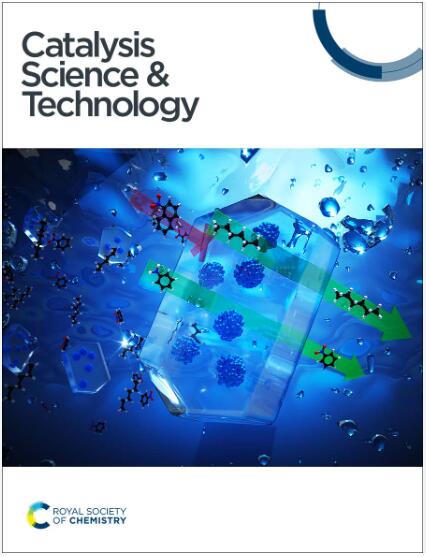Boosting visible light photocatalytic oxidation of CO using Au nanocatalysts through synergistic preparation of an Fe-doped TiO2 support and cold plasma treatment†
IF 4.4
3区 化学
Q2 CHEMISTRY, PHYSICAL
引用次数: 0
Abstract
TiO2-supported Au nanocatalysts are highly attractive for visible light photocatalysis owing to their efficient surface plasmon resonance (SPR) and superior intrinsic catalytic activity. The prevailing strategies to prepare high-performance plasmonic Au/TiO2 include constructing highly active Au–TiO2 interfaces by modulating the electronic and geometric properties of Au nanoparticles or the TiO2 support. Herein, we report a synergism of an Fe-doped TiO2 (Fe@TiO2) support and cold plasma treatment for the preparation of an Au/Fe@TiO2–P catalyst, enabling this Au nanocatalyst to outperform samples fabricated via classical methods for the visible light photocatalytic oxidation of CO. The key to this collaborative preparation is treating the Au species on Fe@TiO2 derived from hydrothermal synthesis with cold plasma, which constructs large numbers of Au–Fe@TiO2 interfaces by generating unique interactions between Au nanoparticles and the support. The Au/Fe@TiO2–P catalyst features high dispersion of Au and abundant surface oxygen species, thus accelerating the visible light photocatalytic oxidation of CO along the hot-electron transfer reaction pathway. This investigation demonstrates a promising approach to design and construct high-performance supported Au nanocatalysts for visible light photocatalysis.
通过协同制备fe掺杂TiO2载体和冷等离子体处理,促进Au纳米催化剂可见光催化氧化CO
二氧化钛负载的金纳米催化剂由于其高效的表面等离子体共振(SPR)和优异的内在催化活性,在可见光催化方面具有很高的吸引力。制备高性能等离子体Au/TiO2的常用策略包括通过调节Au纳米粒子或TiO2载体的电子和几何性质来构建高活性Au/TiO2界面。本文中,我们报道了铁掺杂TiO2 (Fe@TiO2)载体和冷等离子体处理协同作用制备Au/Fe@TiO2 -P催化剂,使该Au纳米催化剂在可见光催化氧化CO方面优于经典方法制备的样品。这种协同制备的关键是用冷等离子体处理水热合成Fe@TiO2上的Au物质。它通过在金纳米颗粒和载体之间产生独特的相互作用来构建大量的Au - Fe@TiO2界面。Au/Fe@TiO2 -P催化剂具有高度分散的Au和丰富的表面氧,从而加速了CO在可见光下的热电子转移反应途径的氧化。本研究展示了一种设计和构建用于可见光催化的高性能负载金纳米催化剂的有前途的方法。
本文章由计算机程序翻译,如有差异,请以英文原文为准。
求助全文
约1分钟内获得全文
求助全文
来源期刊

Catalysis Science & Technology
CHEMISTRY, PHYSICAL-
CiteScore
8.70
自引率
6.00%
发文量
587
审稿时长
1.5 months
期刊介绍:
A multidisciplinary journal focusing on cutting edge research across all fundamental science and technological aspects of catalysis.
Editor-in-chief: Bert Weckhuysen
Impact factor: 5.0
Time to first decision (peer reviewed only): 31 days
 求助内容:
求助内容: 应助结果提醒方式:
应助结果提醒方式:


